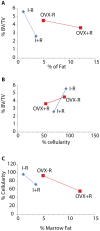The influence of therapeutic radiation on the patterns of bone marrow in ovary-intact and ovariectomized mice
- PMID: 22880075
- PMCID: PMC3412808
- DOI: 10.1371/journal.pone.0042668
The influence of therapeutic radiation on the patterns of bone marrow in ovary-intact and ovariectomized mice
Abstract
Background: The functional components of bone marrow (i.e., the hematopoietic and stromal populations) and the adjacent bone have traditionally been evaluated incompletely as distinct entities rather than the integrated system. We perturbed this system in vivo using a medically relevant radiation model in the presence or absence of ovarian function to understand integrated tissue interaction.
Methodology/principal findings: Ovary-intact and ovariectomized mice underwent either no radiation or single fractional 16 Gy radiation to the caudal skeleton (I ± R, OVX ± R). Marrow fat, hematopoietic cellularity, and cancellous bone volume fraction (BV/TV %) were assessed. Ovariectomy alone did not significantly reduce marrow cellularity in non-irradiated mice (OVX-R vs. I-R, p = 0.8445) after 30 days; however it impaired the hematopoietic recovery of marrow following radiation exposure (OVX+R vs. I+R, p = 0.0092). The combination of radiation and OVX dramatically increases marrow fat compared to either factor alone (p = 0.0062). The synergistic effect was also apparent in the reduction of hematopoietic marrow cellularity (p = 0.0661); however it was absent in BV/TV% changes (p = 0.2520). The expected inverse relationship between marrow adiposity vs. hematopoietic cellularity and bone volume was observed. Interestingly compared with OVX mice, intact mice demonstrated double the reduction in hematopoietic cellularity and a tenfold greater degree of bone loss for a given unit of expansion in marrow fat.
Conclusions/significance: Ovariectomy prior to delivery of a clinically-relevant focal radiation exposure in mice, exacerbated post-radiation adipose accumulation in the marrow space but blunted bone loss and hematopoietic suppression. In the normally coupled homeostatic relationship between the bone and marrow domains, OVX appears to alter feedback mechanisms. Confirmation of this non-linear phenomenon (presumably due to differential radiosensitivity) and demonstration of the mechanism of action is needed to provide strategies to diminish the effect of radiation on exposed tissues.
Conflict of interest statement
Figures





References
-
- Chen Z, Maricic M, Bassford T, Pettinger M, Ritenbaugh C, et al. (2005) Fracture risk among breast cancer survivors: Results from the Women's Health Initiative Observational Study. Archives of Internal Medicine 165: 552. - PubMed
-
- Baxter N, Habermann E, Tepper J, Durham S, Virnig B (2005) Risk of pelvic fractures in older women following pelvic irradiation. JAMA 294: 2587–2593. - PubMed
-
- Hui SK, Fairchild GR, Kidder LS, Sharma M, Bhattacharya M, et al. (2012) Skeletal Remodeling Following Clinically Relevant Radiation-Induced Bone Damage Treated with Zoledronic Acid. Calcified Tissue International 90: 40–49. - PubMed
-
- Despars G, St-Pierre Y (2011) Bidirectional interactions between bone metabolism and hematopoiesis. Experimental hematology 39: 809–816. - PubMed
Publication types
MeSH terms
Grants and funding
LinkOut - more resources
Full Text Sources

